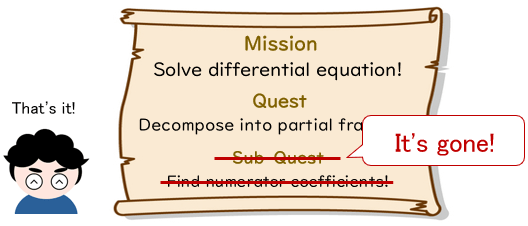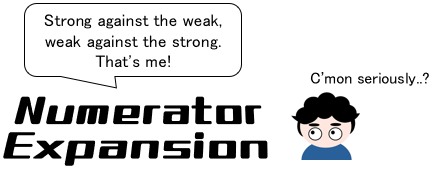This page introduces an alternative partial fraction decomposition technique—the numerator expansion method, to the comparing coefficients method and Heaviside cover-up method. We explain advantages and disadvantages with suitable examples.
Note: This page is a continuation of the page below. You may only read this page, but you will get more clarification if you read both.
- Partial fraction decomposition becomes easy if the numerator is expanded into the form: (denominator factor × something) ± (denominator factor × something).
- This approach makes a simple decomposition simpler whereas a complex decomposition becomes more complex.
- It eases most manual calculations of partial fraction decompositions in practice.
Drawbacks of Comparing Coefficients and Heaviside Cover-up Methods
Let’s review previously mentioned drawbacks.
- The decomposed form has to be predicted correctly at first.
- The Heaviside cover-up method requires the degree of the denominator factors to be 1.
- Even though we just want to decompose fractions, we need to solve another problem to find the coefficients of the numerator.

Useful Tip: Numerator Expansion Method
We resolve the above problem by applying another partial fractional decomposition method. For convenience, we refer to this method as the numerator expansion method.
Basic Example 1
Let’s first decompose the following simple fraction with the numerator expansion method.
$$\frac{6}{(s+4)(s+1)}$$
The denominator is the product of two terms: $(s+4)$ and $(s+1)$. First of all, express (expand) the numerator by adding or subtracting these factors.
$$\frac{6}{(s+4)(s+1)}\ =\ \osgd{\frac{(s+4)-(s+1)}{(s+4)(s+1)}}{\large \text{Subtraction between}}{\large \text{Denominator Factors}}\cdot 2$$
The numerator is expanded as the subtraction between denominator factors. Note, it is multiplied by 2 for equality.
Just interpret it as subtracting out the unneeded $s$ and then multiplying the remaining terms by a constant to keep the equality.
All that remains is to decompose the fractions by each term.
$$\begin{align}\frac{(s+4)-(s+1)}{(s+4)(s+1)}\cdot 2 &= 2\bigg\{ \frac{s+4}{(s+4)(s+1)}\ -\ \frac{s+1}{(s+4)(s+1)}\bigg\} \\[10pt]&= \frac{2}{s+1}\ -\ \frac{2}{s+4}\end{align}$$
Basic Example 2
Let’s move forward to a bit complex example. Consider the decomposition of the following fraction:
$$\frac{3s}{(s+4)(s+1)}$$
The denominator factors remain the same, i.e. $(s+4)$ and $(s+1)$. Consider adding or subtracting these denominator factors to make $3s$ in the numerator.
In this case, we need $s$ in the numerator, so what we don’t need is— a constant term. To eliminate it, we multiply one of the factors by a constant and subtract as follows:
$$\frac{3s}{(s+4)(s+1)}\ =\ \frac{(s+4)\osgd{-4(s+1)}{\large \text{Multiply}}{\large \text{& Subtract}}}{(s+4)(s+1)}\cdot (-1)\ =\ -\frac{1}{s+1} + \frac{4}{s+4}$$
Note that $(-1)$ is multiplied to keep the equality.
Thus, the numerator expansion method performs the decomposition by expanding the numerator into the form “(denominator factor × something) ± (denominator factor × something).”
Advantages and Disadvantages of the Numerator Expansion Method
Advantages
No Sense of Sub-Quest
The greatest advantage of the numerator expansion method is to get the decomposition by transforming the numerator term in a single step.
It is devoid of lengthy and tedious multiple stages like the comparing coefficients method or the Heaviside cover-up method.
$$\begin{gather}\color{green}{\text{Formula deformation does decomposition!}}\\[5pt]\frac{6}{(s+4)(s+1)}\ =\ \frac{(s+4)-(s+1)}{(s+4)(s+1)}\cdot 2\ =\ \frac{2}{s+1}\ – \ \frac{2}{s+4} \\[10pt]\frac{3s}{(s+4)(s+1)}\ =\ \frac{(s+4)-4(s+1)}{(s+4)(s+1)}\cdot (-1)\ =\ -\frac{1}{s+1} + \frac{4}{s+4}\end{gather}$$

No Need to Predict Decomposed Form
The decomposed form is not predicted at first unlike the comparing coefficients method or the Heaviside cover-up method. Therefore, you can use it as a last resort when the decomposed form is obscure.

It’s not so hard for me to remember the decomposed form…
Then, just recall them and apply that knowledge for verification. In other words, by checking whether the result by the numerator expansion method is as predicted, you can immediately notice a mistake.
No Need for Degree of Denominator Factors to be 1
The Heaviside cover-up method constraints with the degree of the denominator factor, i.e. 1. On the other hand, the numerator expansion method does not have that restriction. Impressive!
$$\frac{1}{(s+1)\ubg{(s^2+4s+6)}{\large \text{No Problem!}}}$$
Some complex examples including denominator as a second degree factor will be discussed later.
Disadvantages
The disadvantage is that the calculation becomes cumbersome if the numerator has more than three terms or the denominator has more than three factors.
$$\usg{\osg{\frac{s^2+3s+5}{(s+1)(s+2)(s+3)}}{\large \text{More than 3 terms}}}{\large \text{or more than 3 factors}}$$
As you can see in the later examples, simply put, the numerator expansion method is a method in which simple decompositions become simpler and complex decompositions become more complex. Prefer other methods when encountering a decomposing complex fraction.

Nevertheless, generally partial fraction decompositions are not complex in practice. Just recall it, you would go smooth with calculations.
Note: In control engineering, the numerator expansion method is particularly useful because partial fraction decomposition is often carried out to solve differential equations using the Laplace transform. It works excellently, as many systems in control engineering have simple denominators and numerators. For more information on the Laplace transform, please see this page:
Examples of Numerator Expansion Method
Let us learn basics of the numerator expansion method through a bit more complex examples.
Numerator: a Polynomial
$$\frac{3s+6}{(s+4)(s+1)}$$
For instance, numerator consists multiple terms. In this case, we can apply the same approach as before, i.e. simply breaking it down into additions for each term.
$$\begin{align}\frac{3s+6}{(s+4)(s+1)}&=\ubg{\frac{3s}{(s+4)(s+1)}}{\large \text{Example earlier}} + \ubg{\frac{6}{(s+4)(s+1)}}{\large \text{Example earlier}}\\[7pt] &= \bigg(-\frac{1}{s+1} + \frac{4}{s+4}\bigg) + \bigg(\frac{2}{s+1}\ – \ \frac{2}{s+4}\bigg) \\[7pt] &= \frac{1}{s+1}+\frac{2}{s+4}\end{align}$$
If you are a math pro, you may directly expand the numerator, as shown below.
$$\frac{3s+6}{(s+4)(s+1)}\ =\ \frac{(s+4)+2(s+1)}{(s+4)(s+1)}\ =\ \frac{1}{s+1}+\frac{2}{s+4} $$
In practice, it might be difficult to do so. Let’s just think of it as a lucky break if you get an idea. Whereas, this form by calculation requires the same calculations as the comparing coefficients method. Therefore, you should use different methods depending on the situation.
Denominator Factors: 1st Degree × Quadratic Equation
In this case, the denominator is a quadratic equation. If you master this case, you can decompose fractions that the Heaviside cover-up method cannot handle.
Example 1
$$\frac{1}{s(s^2+4s+6)}$$
The concept is the same as before. Since we only need the constant term in the numerator, the other terms are eliminated by operations between the denominator factors.
Herein, $s^2+4s$ of the denominator factor $(s^2+4s+6)$ is extra, so just multiply the other denominator factor $s$ by $(s+4)$ and eliminate it.
$$\begin{align}\frac{1}{s(s^2+4s+6)}&= \frac{(s^2+4s+6)-\osgd{s\color{green}{(s+4)}}{\large \text{Delete extra}}{\large \text{terms with this}}}{s(s^2+4s+6)}\cdot \frac{1}{6} \\[7pt]& = \frac{1}{6}\bigg( \frac{1}{s}\ -\ \frac{s+4}{s^2+4s+6}\bigg)\end{align}$$
Example 2
$$\frac{1}{(s+1)(s^2+4s+6)}$$
It is a bit more complicated with similar idea. The extra term in the denominator factor $(s^2+4s+6)$ is $s^2+4s$, so think, what can be the multiplier to the other denominator factor $(s+1)$? In this case, it’s $(s+3)$!
$$\begin{align}\frac{1}{(s+1)(s^2+4s+6)}&= \frac{(s^2+4s+6)-\osgd{(s+1)\color{green}{(s+3)}}{\large \text{Delete extra}}{\large \text{terms with this}}}{(s+1)(s^2+4s+6)}\cdot \frac{1}{3} \\[7pt] &= \frac{1}{3}\bigg( \frac{1}{s+1}\ -\ \frac{s+3}{s^2+4s+6}\bigg)\end{align}$$
Although we have to consider the operation like the inverse of factoring, it becomes smooth after time being.
Example 3
$$\frac{s}{(s+1)(s^2+4s+6)}$$
Here, the term to remain in the numerator is $s$. Let’s decompose it using the same approach.
The extra term in the denominator factor $(s^2+4s+6)$ is $s^2+6$, so we create it by multiplying the other denominator factor $(s+1)$ by $(s+6)$.
$$\begin{align}\frac{s}{(s+1)(s^2+4s+6)}&= \frac{(s^2+4s+6)-\osgd{(s+1)\color{green}{(s+6)}}{\large \text{Delete extra}}{\large \text{terms with this}}}{(s+1)(s^2+4s+6)}\cdot \bigg( – \frac{1}{3} \bigg) \\[7pt] &= -\frac{1}{3}\bigg( \frac{1}{s+1}\ -\ \frac{s+6}{s^2+4s+6}\bigg)\end{align}$$
Example 4
In the case where the numerator is $s^2$, the same approach can be applied.
$$\begin{align}\frac{s^2}{(s+1)(s^2+4s+6)}&= \frac{(s^2+4s+6)-\osgd{(s+1)\color{green}{(-2s+6)}}{\large \text{Delete extra}}{\large \text{terms with this}}}{(s+1)(s^2+4s+6)}\cdot \frac{1}{3} \\[7pt] &= \frac{1}{3}\bigg( \frac{1}{s+1}+\frac{2s-6}{s^2+4s+6}\bigg)\end{align}$$
Denominator Factors: 1st Degree × (Square of s ± Constant)
Next, the denominator factor shows $(s^2+a)$ form.
$$\begin{align}\frac{1}{(s+1)(s^2+6)}&= \frac{(s^2+6)-\osgd{(s+1)\color{green}{(s-1)}}{\large \text{Delete extra}}{\large \text{terms with this}}}{(s+1)(s^2+6)}\cdot \frac{1}{7} \\[7pt] &= \frac{1}{7}\bigg( \frac{1}{s+1}\ -\ \frac{s-1}{s^2+6}\bigg)\end{align}$$
Here, the extra term is $s^2$; the key point is that the other denominator factor $(s+1)$ is multiplied by $(s-1)$ to avoid $s$.
Denominator involves 3 Factors
In this case, it is difficult to decompose it all at once as before. Therefore, it is necessary to steadily break it down into several pieces as follows.
$$\begin{align}\frac{1}{(s+1)(s+2)(s+3)}&= \frac{(s+2)-(s+1)}{(s+1)(s+2)(s+3)} \\[7pt]&= \frac{1}{(s+1)(s+3)}\ -\ \frac{1}{(s+2)(s+3)} \\[7pt] & = \frac{(s+3)-(s+1)}{(s+1)(s+3)}\cdot \frac{1}{2}\ -\ \frac{(s+3)-(s+2)}{(s+2)(s+3)}\\[7pt] &=\frac{1}{2}\bigg( \frac{1}{s+1} \ -\ \frac{1}{s+3}\bigg)- \frac{1}{s+2} + \frac{1}{s+3}\\[7pt]&= \frac{1}{2}\cdot \frac{1}{s+1} \ -\ \frac{1}{s+2}\ +\ \frac{1}{2}\cdot \frac{1}{s+3}\end{align}$$
Since the hassle becomes greater, you may use other methods according to your preference.
This page explained the numerator expansion method—a useful technique for partial fraction decomposition.
Please refer to this page for examples of differential equation solved with the numerator expansion method.
- Partial fraction decomposition becomes easy if the numerator is expanded into the form: (denominator factor × something) ± (denominator factor × something).
- This approach makes a simple decomposition simpler whereas a complex decomposition becomes more complex.
- It eases most manual calculations of partial fraction decompositions in practice.





Comments